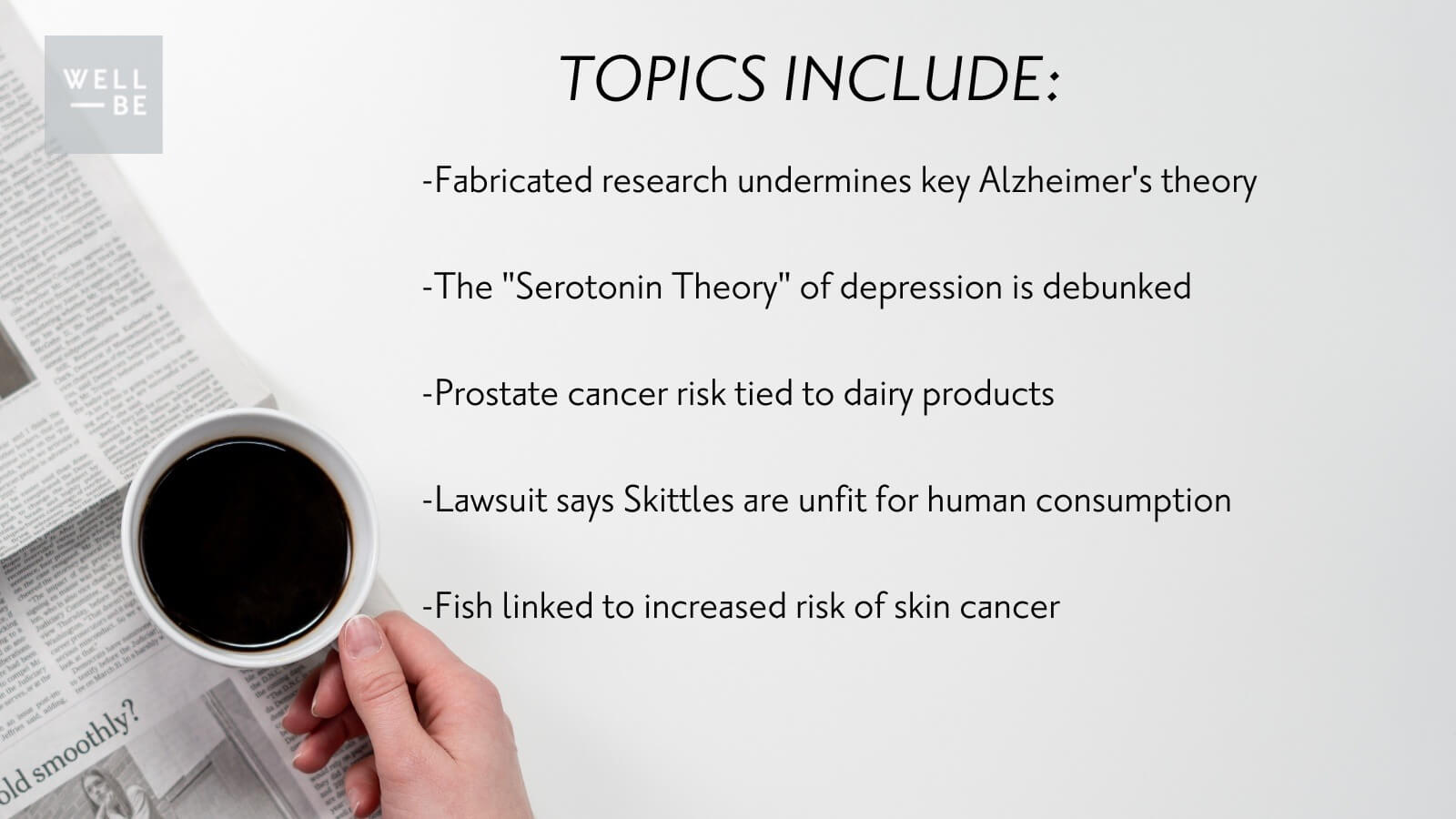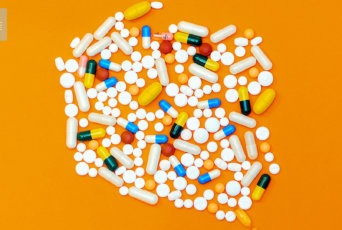Welcome to the health research and wellness news wrap-up for Q3 of 2022! In it, we cover all the most important pieces of health research and wellness news since our last wrap-up, which means from July through September 2022.
This go-round, there was just SO much news that we couldn’t narrow it down to eight topics like we normally do. Instead, we’re playing around with a new format, offering you five big, juicy health topics with WellBe analysis (including two huge debunkings that are rocking the scientific community), plus seven “quick hits” that you can choose to learn more about at the links included. And, for the first time in literally YEARS, there’s no Covid news in this wrap-up! That’s something to celebrate!
So without further ado, we present the 12 most important health and wellness news stories to know about in October 2022 (click to skip to one):
- The Pervasive “Serotonin Theory of Depression” Is Debunked
- Exposure of Fabricated Research Undermines Key Alzheimer’s Theory
- Cognitive Health Roundup: 3 Ways to Protect Your Brain, and 2 Things that Harm It
- Pesticides and Your Health: An EU ban, An Obvious Ruling, and a Startling Finding
- “Forever Chemicals” Are Very Dangerous, But a New Advisory and Scientific Breakdown Can Help
- New AAP Breastfeeding Recommendations Make Waves
- Fish May Raise Skin Cancer Risk — But You Don’t Need to Give It Up
- Treatment-Resistant Depression Might Be Helped By…Magnets?
- Lawsuit Alleges Skittles Are Unfit for Human Consumption
- J&J Talc Finally Pulled From Shelves
- Dairy Products May Raise Risk of Prostate Cancer
- Breast Implant-Related Cancer May be Double FDA Estimates
MAJOR HEALTH HEADLINES
1. The Pervasive “Serotonin Theory of Depression” Is Debunked
What: A comprehensive, exhaustive meta-analysis of previous research has determined that the idea that depression is due to a “chemical imbalance” and low levels of serotonin has no scientific basis.
The Details: The notion that depression is caused by an imbalance of chemicals in the brain — specifically, suboptimal levels of serotonin — was first proposed in 1965 by a Harvard psychiatrist. In the 50+ years since then, repeated research has called that hypothesis into question, and yet the belief persists among the public, in clinical settings, and throughout the mental health industry. Surveys show that up to 90% of people think low serotonin causes depression, and 46% of psychology students report being taught this theory.
This new study brings together a massive amount of research and other documents from the past five decades to show, somewhat definitively, that this theory has no basis in science. Notably, their findings revealed that the FDA was skeptical of the serotonin theory, and only allowed SSRIs (selective serotonin reuptake inhibitors, a class of antidepressants that is meant to raise serotonin levels in the brain) to be marketed with clear qualifying phrases: depression may be caused by a chemical imbalance; SSRIs may modestly outcompete placebo, which is presumed to be due to the serotonin. There was no actual research to back up the idea of SSRIs as an effective treatment for depression. It was, as the lead researchers on the study put it, the “marketing of a myth,” and there is, in fact, no such thing as a “correct” balance of serotonin in the brain.
The study is a peer-reviewed umbrella review that included meta-analyses and other systematic reviews on serotonin, involving tens of thousands of participants. The takeaway from this impressive and exhaustive review is simple: there is “no support for the hypothesis that depression is caused by lowered serotonin activity or concentrations.”
Why This Matters for Your Health & Our Takeaway: One of the biggest consequences of this pervasive fallacy has been the rise in antidepressant prescriptions in our culture. The popularity of the serotonin theory has led to an explosion in prescriptions of SSRIs and other antidepressants since the 1990s; while it was once rare to be prescribed one, now over 13% of Americans take antidepressants. We’re never fans of taking pharmaceuticals when there might be other, more holistic ways to treat a problem, and this staggering new research makes it abundantly clear that SSRI antidepressants have no scientific basis for helping with depression (for a potential, pharmaceutical-free alternative, check out our Health Quick Hits below!). What’s more, it underscores the importance of doing your own research rather than relying on conventional wisdom or a doctor’s advice — countless people have made uninformed decisions about taking antidepressants because they (understandably) chose to trust their practitioner (who was likely marketed to by pharmaceutical companies and did not perhaps know that antidepressants were not evidence-supported).
2. Exposure of Fabricated Research Undermines Key Alzheimer’s Theory
What: A new investigation uncovered evidence that findings from an influential 2006 study may have been fabricated to falsely support the idea that Alzheimer’s is caused by a certain type of plaque in the brain.
The Details: In an oft-cited 2006 study published in Nature, researchers put forth the theory that a subtype of protein — amyloid beta star 56 — were the main cause of Alzheimer’s, causing sticky plaques in the brain that interfere with cognitive function. This caused a big splash and became one of the leading theories of Alzheimer’s etiology.
Sixteen years later, however, a 6-month investigation from Science magazine exposed evidence that images in the study may have been doctored. Tipped off by a whistleblower, researchers looked into the evidence, and found more than 20 “suspect” papers and over 70 instances where an image may have been tampered with to inflate the role of the amyloid beta star 56 protein in the development of Alzheimer’s. Coupled with the fact that researchers were unable to replicate the results of the 2006 study, this casts extreme doubt over the plaque hypothesis.
Why This Matters for Your Health & Our Takeaway: In part due to this 2006 study, more than $1 billion of government funding has gone toward amyloid-related Alzheimer’s research — and while experts say that the theory shouldn’t be completely discredited, it’s hard not to feel that this funding may have been wasted. We’re reminded, yet again, to not blindly trust something just because it’s published in a scientific journal — things need to be both peer-reviewed and replicated in order to be reliable.
The good news is that we do have actual evidence of things that can both cause and prevent cognitive decline. In fact, let’s get into that right now…
3. Cognitive Health Roundup: 3 Ways to Protect Your Brain, and 2 Things that Harm It
What: Two new studies show that both HSV (herpes) and lack of fitness in childhood can lead to dementia, while three others identified potential ways to protect against it: keeping a routine, getting regular exercise, and taking omega-3 supplements.
The Details: While the plaque theory of Alzheimer’s progression has been called into question, two studies suggest some other potential causes. For some time, researchers have been looking into whether herpes simplex virus type 1 (HSV-1) is related to Alzheimer’s, and have found that the microbe exists in the human brains of older people and when combined with a specific genetic factor, can raise risk of developing Alzheimer’s disease. A new study by these same researchers looked at a different kind of herpes virus (VZV), the one that causes chickenpox and shingles, and found that it was associated with inflammation in the brain and reactivation of HSV, which can remain dormant for years in the body. Their conclusion? In humans, viral infections like VZV can cause inflammation in the brain, and reactivate the dormant HSV-1 virus.
Another study followed 1,200 people over the course of 30 years, mapping their childhood fitness levels to their cognitive function later in life. In the initial part of the study, participants between age 7 and 15 had their fitness assessed (cardiovascular ability, strength, endurance) and their waist-to-hip ratio measured. In the follow-up, some 30 years later, participants used a series of computerized tests to assess their cognitive function. Researchers found that people who were the most fit as kids had the highest processing speed and attention and overall cognitive function.
But the benefits of fitness don’t stop in childhood. Yet another study found that regular exercise in adulthood can slow mental decline. The 18-month study followed 300 or so participants over the age of 65 with mild cognitive impairment (MCI). They were all assigned to either an aerobic training program or a regimen of less intense stretching exercises. Over the period of the study, none of the participants experienced cognitive decline — while a control group who didn’t exercise at all showed significant decline over the same time period. This is the longest MCI study to date, and is pretty powerful evidence that fitness for older adults matters a lot in terms of dementia prevention.
And it’s not just official “exercise” that matters for your brain — it’s your activity level overall. A study published in JAMA found that older adults who rise early, stay active throughout the day, and stick to a regular routine (all three are important!) have better cognitive performance than those who don’t. The study measured the activity of 1,800 adults over age 65 for seven days using fitness trackers, and grouped them into three categories: those who got up early, stayed active throughout the day, and kept a consistent daily routine; those who got up later and were less active, but had consistent routines; and those who had no consistent routine. After the activity tracking portion, researchers assessed their cognitive function and mental health with questionnaires. The results showed that those in the first group were the happiest and had the best cognitive function; those in the second group had markedly worse cognition and were more depressed; and those in the last group had the highest rates of depression and the worst cognitive function.
So besides staying active, what else can you do to keep your brain healthy? Well, recent research suggests something pretty darn easy might help: taking omega-3 supplements (learn more about the importance of omega-3’s in our new guide to healthy fats). In a new study, researchers looked at about 1,500 participants under the age of 65, and found that those with the highest levels of DHA — a type of omega-3 fat — were 49% less likely to develop Alzheimer’s. That’s a pretty eye-opening number! DHA is thought to protect against Alzheimer’s by reducing inflammation in the brain, and can be found in foods like fatty fish (salmon, sardines, mackerel), as well as omega-3 supplements.
Why This Matters for Your Health & Our Takeaway: While every organ you have is important, the brain arguably trumps them all — so protecting it is incredibly important. What’s more, there’s no current treatment available for Alzheimer’s, so prevention is vital. Thankfully, as this abundance of research shows us, there are things you can do. Staying fit (and if you have kids, encourage them to engage in regular physical activity), keeping a routine as much as you can, and taking an omega-3 supplement are all pretty low-hanging fruit that can make an enormous difference for your future. We’re setting a recurring alarm for 7AM and adding omega-3’s to our shopping list — who else is in??
4. Pesticides and Your Health: An EU Ban, An Obvious Ruling, and a Startling Finding
What: First, the good news: the EU has announced a plan to cut pesticide use in half by 2030, and a federal court rejected the Trump-era finding that glyphosate (the active ingredient in Roundup) is “safe.” Now, the scary news: a large government study found that glyphosate was present in the urine of 80% of the U.S. population.
The Details: The European Commission proposed a law that would aim to cut pesticide use in half by 2030 and completely ban pesticide use near schools, playgrounds, and hospitals. While it could take up to a year to become official legislation, after which EU members will have two years to create plans to meet certain targets. The law is part of a larger set of goals to restore 20% of land and seas and reduce biodiversity loss.
There’s also pesticide progress on our side of the Atlantic. In 2020, the EPA issued a finding stating that glyphosate doesn’t pose any risk to human health and is not likely to cause cancer — and past summer, a federal appeals court rejected that finding, saying that it was not supported by substantial evidence and also accusing the EPA of shirking their duty to consider the Endangered Species Act. Bayer, the company that makes Roundup (the most widely used herbicide in the world) is currently being sued by thousands of people who claim exposure to the chemicals caused their cancer. The EPA is now in the process of reviewing the ruling and will determine next steps from there.
And hopefully they don’t take too long to determine next steps, since the issue of glyphosate in our environment is a pressing one. A new government study, which was part of a CDC program, examined urine samples from a representative group of 2,310 Americans (nearly a third of whom were kids), and found that 80% of them had glyphosate in their urine. Bayer has already said it will remove glyphosate from Roundup for the residential market by 2023, but given that industrial farms — who grow much of the food consumed by adults and children alike — can still use it, this is unlikely to tamp down the risk caused by the herbicide.
Why This Matters for Your Health & Our Takeaway: While the EU ban and the court ruling are steps in the right direction, this collection of stories reminds us once again that our health is often not a priority for the government and big corporations, making it essential that we take steps to protect ourselves and our loved ones. In the case of glyphosate, thankfully, the workaround is fairly simple: buy organic whenever possible.
5. “Forever Chemicals” Are Very Dangerous, But a New Advisory and Scientific Breakthrough Can Help
What: New research shows that “forever chemicals” can more than quadruple your risk of developing liver cancer. Thankfully, the EPA also announced new drinking water health advisories for these chemicals, and a scientific breakthrough may mean that these chemicals no longer stick around “forever.”
The Details: Forever chemicals are all the thousands of chemicals that fall into the category of per- and polyfluoroalkyl substances, also known as PFAS. They got their nickname because they can take years to degrade in the body and the environment, and they’ve been linked to a variety of health issues. They’re commonly found in kitchenware (like nonstick pans), but are also found in tap water, waterproof clothing, cleaning products, and more.
A new study compared 50 people who had developed liver cancer with 50 others who did not. They analyzed pre-diagnosis blood samples from the cancer group and compared it with the control group, and found that those who were in the top 10 percent of exposure to PFAS were 4.5 times more likely to develop liver cancer.
In better news, the EPA released four new drinking water health advisories for PFAS. These advisories indicate the maximum level of PFAS that can exist in drinking water before adverse health effects occur, and are meant to guide federal, state, and local officials in their plans and policies around drinking water. Along with the advisories, the agency also invited states and territories to apply for $1 billion in grants meant to address PFAS in drinking water.
These advisories are a good thing, especially coupled with the fact that earlier this year, the EPA cut the acceptable level of PFAS in household products by more than 99%. However, they do nothing to address the fact that many people already have PFAS-containing products in their homes, where they can be doing serious damage. A new scientific breakthrough might help that. PFAS are called forever chemicals because they’re incredibly difficult to break down — they contain many carbon and fluorine bonds, which are the strongest bonds in organic chemistry and the reason that PFAS are so good at repelling water, oil, and stains (hence why they’re used in waterproof clothing and nonstick pans). But new research out of Northwestern University might have found a way to break them down inexpensively, by using sodium hydroxide, a common chemical compound used in household products like soap and painkillers. More research is needed, but scientists are hopeful that this method could be used to both destroy the contaminants in existing products and filter them out of drinking water in the future.
Why This Matters for Your Health & Our Takeaway: Scientific breakthroughs and consumer-protecting bans are great. But just as with pesticides, we know that we can’t rely on corporations or the government to keep us safe from harmful chemicals. To that end, we’ll continue to use a high-quality water filter and only fill our homes with vetted, non-toxic products.
HEALTH QUICK HITS
6. New AAP Breastfeeding Recommendations Make Waves
The American Academy of Pediatrics updated its breastfeeding guidelines for the first time in a LONG time — the first time since 2012. While they’ve long advised that mothers breastfeed from 6 months to one year, they now advise 6 months to two years. This recommendation was based on evidence of the continued benefits of breastmilk into toddlerhood, and prompted calls for breastfeeding mothers to have more support. If you or someone you know is struggling with breastfeeding (it’s not easy!!), check out our interview with lactation consultant Andrea Syms-Brown, the woman who transformed Adrienne’s experience with breastfeeding.
7. Fish May Raise Skin Cancer Risk — But You Don’t Need to Give It Up
A new study tied greater consumption of tuna and other fish to an increased risk of melanoma, the deadliest type of skin cancer. They hypothesize that this may not be due to the fish itself but to the contaminants within it (like dioxins, arsenic, and mercury). The study looked at almost half a million adults, and found that those who ate the most fish on average had a 22% higher risk of malignant melanoma than those who ate little fish. Still, other studies show that consumption of omega-3’s, which are abundant in certain fatty fish, can protect against melanoma, so experts don’t advise skipping fish as a way to protect against skin cancer but rather choosing only low mercury fish.
8. Treatment-Resistant Depression Might Be Helped By…Magnets?
A treatment for depression called transcranial magnetic stimulation (TMS) has been used for years — but it takes months to work. A new therapy, dubbed Stanford neuromodulation therapy (SNT) also uses magnetic fields to stimulate the brain, but works much more quickly. Experts still aren’t entirely sure how it works, but the evidence says it does — especially for those whose depression hasn’t responded to therapy or medication (although we now know why those SSRIs may not be working…). With SNT, patients get 10 treatments a day for five days — and a new study shows that the approach can result in a 52% reduction in depression symptoms, as compared to a control group that saw an 11% reduction.
9. Lawsuit Alleges Skittles Are Unfit for Human Consumption
Don’t make candy lovers mad. A new lawsuit from a woman in Oakland accuses Mars, Inc, the manufacturer of Skittles, of selling a product that’s unfit for human consumption. The lawsuit alleges that Skittles contain high levels of titanium dioxide, which has been associated with a whole host of health problems and is banned for consumption in the EU. Taste the rainbow — of toxins! We have long recommended skipping anything artificially colored, and now a lawsuit is backing us up!
10. J&J Talc Finally Pulled From Shelves
We’ve been covering the whole saga around Johnson & Johnson baby powder and allegations it causes cancer for some time. Finally, the chapter appears to be coming to a close: after tens of thousands of lawsuits alleging that asbestos in the product can cause cancer, the company is fully abandoning its talc-based baby powder next year, and will now make it with cornstarch. The company still denies that their talcum powder is the cause of ovarian cancer, but has decided to put the issue to rest by getting rid of it entirely. Consider this a consumer awareness and advocacy win.
11. Dairy Products Linked to Prostate Cancer Risk
A large new study draws a direct line between dairy intake and prostate cancer risk. The study used questionnaires and phone calls to track the dairy intake of over 28,000 North American men, and then compared these findings with prostate cancer registries over a 7.8 year period, on average. They found that men who consumed about 430 grams of dairy per day (almost two cups of milk) had a 25% increased risk of prostate cancer as compared to men who only consumed about 20.2 grams of dairy per day (the equivalent of ½ cup of milk per week). Notably, non-dairy sources of calcium didn’t increase risk at all, suggesting that there’s something specific about dairy from cows — one theory is that this is due to the sex hormone content of dairy milk, since up to 75% of dairy cows are pregnant, and prostate cancer is a hormone-related cancer (this theory also echoes previous research that tied dairy intake to breast cancer).
12. Breast Implant-Related Cancer May be Double FDA Estimates
Once a breast implant is put in, scar tissue begins to form around it, and a certain rare type of lymphoma (a cancer of the lymphatic system) can develop in this scar tissue. Research shows that the risk of this happening is higher in women with textured implants, which women choose because they tend to stay in position better. In 2011, the FDA first reported a possible link between saline and silicone breast implants and lymphoma, and in 2020, they ordered that breast implants be labeled with a warning. However, their understanding of how serious the risk is appears to be way off — a new study looked at cases of breast implant-related lymphoma over an 18-year period (2000 to 2018), and found not only that the rate was increasing over time, but also that instances were more than double FDA estimates. Their findings showed that there were 8.1 million cases per 100 million women, while the FDA puts that number at 3 million cases per 100 million women.









COMMENTS